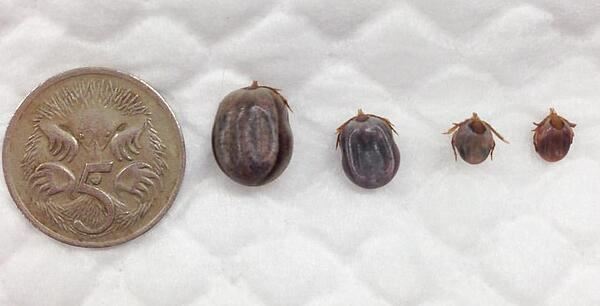Client Resources
Tick Paralysis

Tick paralysis is a common disease seen in dogs and cats in south-east QLD as well as north QLD and parts of NSW. It is caused by a toxin secreted by paralysis ticks that attach to animals’ skin and feed on their blood. Tick paralysis can cause severe illness, and if not recognised and treated, can be fatal.

The Australian paralysis tick (Ixodes holocyclus) is a common parasite found along the eastern coast of Australia, from central NSW up to far north QLD. The paralysis tick is a native species that has co-evolved with many of our wildlife species. Animals such as bandicoots are the native hosts, but paralysis ticks can also be found on possums and some birds for short periods. Generally, Australia’s wildlife is unaffected by the paralysis tick.
The paralysis tick is commonly found in bushland and long grass, and is most active during warm and humid weather.
It is commonly believed that if your animals don’t leave your yard, your grass is short, or that it is the winter season, that you don’t need to worry about paralysis ticks. THIS IS FALSE. Many Australian households have birds and native mammals travelling through, which can bring paralysis ticks into your yard. While keeping the grass short may reduce their preferred habitat, it won’t remove any ticks from your yard.
While we may feel the cold here around the Brisbane, Ipswich, Logan and Scenic Rim region, the temperature doesn’t get low enough in winter to effectively reduce the tick population. It may be true that more cases of tick paralysis are seen during the spring and summer months, however we do still see cases at other times of the year.
Once a tick attaches to an animal and starts to feed on blood, the mouthparts change over 72 hours and begin to secret toxins into the blood stream. Initially this toxin is circulated freely around in the blood and the signs of toxicity may not be noticeable. Once the toxin leaves the blood stream and starts to attach to muscles and nerves, the signs of paralysis begin to show. The exact mechanism of how the toxin affects muscles and nerves isn’t well understood, but the clinical signs and disease processes that follow are well documented.
Diagnosis is made from a thorough clinical history, and identification of a paralysis tick on the animal, or the presence of a “tick crater”. Tick craters are inflammatory swellings at the site where the tick was attached. If no paralysis tick is found on the animal then diagnosis can be difficult, as the clinical signs can sometimes seem similar to other diseases such as spinal disease and heart failure.
There can be a wide variation in clinical signs depending on the severity of paralysis and the individual animal. In cases that are identified early in the disease process there may only be one or two noticeable signs. The common signs seen are:
- Weakness, wobbliness or paralysis of the hindlimbs
- Coughing, gagging or retching
- Abnormal breathing pattern, progressing to laboured breathing and pneumonia
- Vomiting or regurgitation
- Local paralysis around eyes (if the tick was attached to the face)
Typically, the early signs seen are weakness in the hindlimbs, and animals may appear to stagger or wobble in their hindlimbs. Another common early sign is a cough or gag as the muscles used to swallow are affected. As the paralysis worsens, the muscles that help them breathe are affected, and they can go into respiratory failure. Vomiting or regurgitation can occur as the oesophagus become dilated and inactive, known as megaoesophagus. If the animal vomits and accidentally inhales any of the material then pneumonia can occur, worsening the respiratory disease.
Some animals can have difficulty urinating while they are paralysed as the toxin has affected the muscle and nerves controlling bladder function. Animals affected by tick paralysis can also have difficulty maintaining normal body temperature, and are susceptible to getting too cold or too hot.
The paralysis toxin affects muscles all over the body, including the heart muscle. Some patients can suffer from sudden onset of congestive heart failure, and in rare cases can go into cardiac arrest.
Initial treatment is administering Tick Anti-Serum slowly via an intravenous catheter. This product is derived from the blood of a subpopulation of dogs that are naturally immune to the tick toxin. The anti-serum binds up the toxin circulating in the blood stream and prevents it from attaching to muscles and nerves. The anti-serum cannot affect the toxin that is already bound to tissue, but it is given to try to stop the progression of the disease. Over several days the toxin will unbind from tissue and be excreted from the body.
Other treatment involved is based on the severity of the paralysis. If the animal is vomiting or regurgitating and there is a concern about pneumonia developing, then antibiotics are started to manage infection. Medication to try to reduce vomiting and improve the activity of the oesophagus may be given as well. If there is paralysis of the eyelids then topical eye lubricants are applied to try to prevent ulceration of the corneas. Nursing care is critical in these cases; repositioning their body to avoid pressure sores while they are unable to move normally, applying eye lubrications, ensuring their bladder empties normally, monitoring and maintaining body temperature are all crucial in management of tick paralysis.
As their ability to swallow is weakened, no food or water is given by mouth until they are able to swallow normally. During this period, intravenous fluids are given to avoid dehydration. Some medications can be added to the fluids so they are administered continuously.
Tick paralysis patients are often kept sedated so they remain calm and keep their oxygen requirements low. Often these patients are stressed and scared and can panic very easily, causing their ability to breathe to suddenly worsen. In severe cases of paralysis where the respiratory muscles are affected, further treatment with oxygen therapy may be needed. This may be provided via an intra-nasal tube, but in some cases this may still not be enough. The paralysis results in the patient working harder for each breath, and they can become fatigued and exhausted and eventually stop breathing. If the respiratory paralysis is severe enough, then the patient may need to be on a ventilator to help them breathe. These cases must be referred to a 24-hour hospital, as they cannot be left unattended or unsupervised.
Treatment is continued until the clinical signs have disappeared and the animal is able to breathe without oxygen supplementation, swallow safely, urinate on their own, and walk without assistance. The recovery period varies between individuals and can be hard to predict. In-hospital treatment may be as short as 24 hours, but in severe cases can last a week or more.
One of the most difficult things about tick paralysis is its unpredictable nature. Generally speaking, cases that are diagnosed early when the signs are only mild have a faster recovery and low risk of complications, but each case is different and some can take us by surprise. Prognosis worsens as the signs progress and more intensive treatment is required (e.g. mechanical ventilation), but this does not mean that the animal won’t recover. With careful nursing care, medical management and breathing support, we can give each animal the best chance for as good a recovery as possible. However, there are never any guarantees with any case.
If the animal survives tick paralysis, then there are no lasting effects, and they will return to normal after a month or so.
Tick paralysis is a life-threatening disease, and without treatment is often fatal.
There are a range of preventative products available to significantly reduce the risk of your pet being affected by tick paralysis. We recommend either Nexgard or Bravecto for the best tick prevention. Both of these products have excellent success rates and are very safe to give. Nexgard is a once a month oral chewable for dogs (not cats). Bravecto is available as chewable in dogs that can be given once every 3 months, but is also available as a spot-on for cats and dogs.

PREVENTION IS BETTER THAN TREATMENT!
If you are confident that it is definitely a tick, then removing it is step number 1. You can use a tick removal device, tweezers, or your fingernails to remove a tick. Grasp the tick close to the skin and pull firmly. If you remove a tick, keep it in a container or zip-lock bag, so it can be identified.
If you are not sure if you have found a tick, or you are not confident in removing it, phone us and come down to see us at our clinic. We can help you identify if it is a tick or not, and help you remove it if needed. We can then do an examination on your pet and discuss whether treatment is needed or not.
A paralysis tick needs a minimum of 48 hours after attachment to secret toxin into the blood. This means there is narrow window of opportunity to remove a tick before it can secrete toxin, and avoid toxicity and paralysis. However, if the tick has been attached long enough to secret toxin, but not long enough for the toxin to produce clinical signs, there can be a lag period between removing the tick and the onset of signs, meaning that paralysis could still occur after another 24-48hours. If you have found a tick on your pet, please phone us or come down to speak to us about your pet’s health and treatment options.

